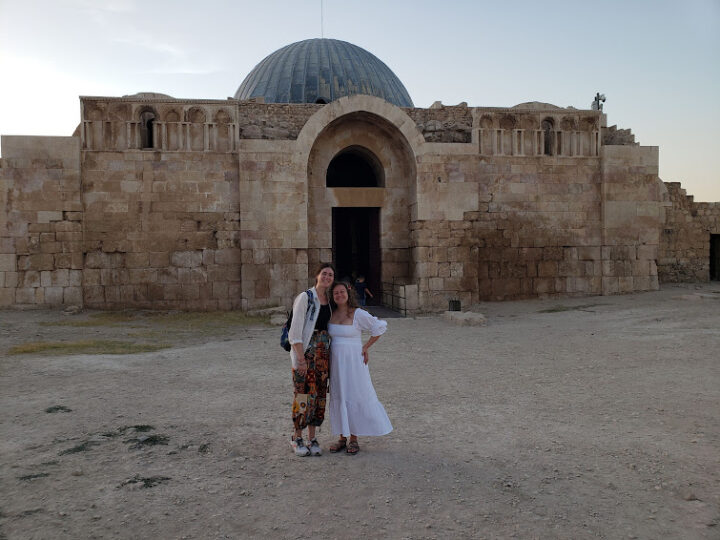by Danielle Wolfson

I am an emerging professional in cultural heritage, chosen by the United States Committee of the International Council on Monuments and Sites (US/ICOMOS) to participate in their International Exchange Program (IEP), an honor that brought me to Amman for the summer of 2022. At the American Center of Research, I worked on the Prevention of Illicit Trafficking of Cultural Property Project under the leadership of Dr. Ahmed Fatima Kzzo. Funded by the Office of Public Affairs at the U.S. Embassy in Amman and in cooperation with the Jordanian Department of Antiquities (DoA), this project aims to combat the illegal acquisition and destruction of antiquities in Jordan and to strengthen national and international efforts to preserve and protect cultural heritage by supporting the DoA’s anti-trafficking unit. My role was to support the initiative by drafting the outline of a training manual for DoA staff and local archaeologists to ensure the project’s sustainability, as well as by analyzing trainees’ data for periodic quarterly reports on the project, preparing designs to be used for public awareness, and undertaking other tasks.
In addition to my work at the American Center, I had the privilege of attending the Fifteenth International Conference on the History and Archaeology of Jordan (ICHAJ 15), with the theme of “Thoughtful Archaeology in the Ecosphere and Sociosphere,” at Yarmouk University. This was the second time I was fortunate enough to visit Irbid, the first being when I visited the Dar As-Saraya Museum for a training program related to the Prevention of Illicit Trafficking of Cultural Property Project.
The conference was inaugurated by HRH Prince Hassan, who delivered an engaging and thoughtful speech about Jordanian cultural heritage. Prince Hassan, a longtime supporter of archaeology and protecting Jordan’s tangible and intangible cultural heritage, made an effort to engage with a variety of presenters during his speech. Over three days, ICHAJ had at least a hundred presentations, five multi-hour workshops, eleven online lectures, and a poster session. Topics discussed included conservation and community participation, capacity-building for sustainable preservation, the fight against illicit cultural-heritage trafficking, and more. I was very appreciative of the conference’s focus on accessibility, as every session was translated into both Arabic and English. This feature fostered a welcoming atmosphere, overcoming the typical issues of language barriers at international conferences.
The lectures provided great insight into the latest research in Jordan. Of particular interest to me, Dr. Helen Malko (associate director for fellowships and programs) and Dr. Ahmed Kzzo (director of the Prevention of Illicit Trafficking of Cultural Property Project) presented the American Center’s illicit-trafficking prevention project on the second day of the conference. It was incredibly special for me to witness research I had participated in crafting presented at an international conference. I also greatly enjoyed hearing from scholars such as Dr. Craig A. Harvey (a former American Center fellow), who presented on Roman marble sculptural fragments found at the site of Humayma. Beyond individual lectures, I attended a two-hour workshop on the Madaba Regional Archaeological Museum Project (MRAMP) hosted at the Museum of Jordanian Heritage at Yarmouk University. The workshop was moderated by Douglas R. Clark, who, along with fellow team members Suzanne Richard and Basem Mahamid, provided an overview of the progression and projections of their exciting project. Additionally, the American Center’s own Jehad Haron (associate director and cultural-heritage resources development lead for its USAID-funded Sustainable Cultural Heritage Through Engagement of Local Communities Project) joined the workshop to present his forthcoming book, a manual about the pottery of Jordan.
To conclude each day of the conference, ICHAJ staff organized fantastic group excursions to archaeological sites near Irbid. In Jerash, I had the privilege to dine with HE Dr. Nayef Himiedi Al Fayez, the minister of tourism and antiquities, and Prof. Fadi Al Balawi, director general of the Department of Antiquities. We traveled to Umm Qais on Thursday evening and dined within the site. I felt very privileged to see the ancient city of Gadara at sunset and take in the view of the Sea of Galilee, the Golan Heights, and the surrounding states. ICHAJ 15 came to a close with a gala dinner at the Amman Citadel (Fig. 2). We genuinely had a red carpet rolled out for us as we walked into dinner serenaded by bagpipes. It was a regal conclusion to an enlightening conference, and I was grateful to be among the international cohort of voices vowing to protect Jordanian history and archaeology.

My welcoming experience at ICHAJ mirrored my time at the American Center. The newly renovated building was pristine, especially the outdoor patios, library, and gym. However, the most significant takeaway from my time at the center has been the network I have crafted here. Having an international cohort of voices to run ideas by, discuss trends among, and share experiences with as foreign scholars was the single most impactful aspect of my time in Jordan. Going forward, these relationships will continue to bolster my understanding of the cultural heritage space and how we safeguard our interwoven histories. I am so thankful that I got to experience living and working in a research center and for the colleagues I met and friendships I made while at the American Center of Research.
Danielle Wolfson is the administrative coordinator at the University of Pennsylvania’s Annenberg Center for Collaborative Communications. She is a cultural heritage specialist with experience in Germany, Greece, and now Jordan. Creating her own major in museum studies, she earned her BA from Drexel University in 2020. Her current research looks at analyzing museums as institutions for social change and current provenance standards.